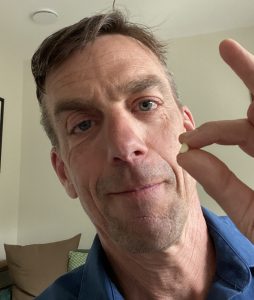Dopamine for Parkinson’s and Everyone Else Too
First…a quick definition. What is Dopamine?
Dopamine is a protein-based neurotransmitter and hormone manufactured in both the brain and body and functions in Movement / Memory / Pleasurable reward and motivation / Behavior and cognition / Attention / Sleep and arousal / Mood / Learning / Lactation. Pop headlines focus on the reward and motivation aspect of dopamine, but the movement portion of dopamine function is very interesting to me given my tremor dominant Parkinson’s. If you really want to deep dive into the Motivation and reward aspect of dopamine, dig into Huberman’s 2 hour podcast – I have listened to it twice.
Getting ON dopamine?…That’s kind of easy, but it is not what most of you want to do. I manage Parkinson’s Disease, and have taken to using ½ tablet of 25 mg carbidopa / 100 mg levodopa twice daily to reduce the stiffness and allow myself to sit still for periods of time and do stuff like travel, clinical office visits and writing. I won’t go into the details of how this drug combination works together but it is synergistically cool.
manage Parkinson’s Disease, and have taken to using ½ tablet of 25 mg carbidopa / 100 mg levodopa twice daily to reduce the stiffness and allow myself to sit still for periods of time and do stuff like travel, clinical office visits and writing. I won’t go into the details of how this drug combination works together but it is synergistically cool.
What’s interesting is that I, the natural health doc, chose the drug Rx version rather than a natural legume supplement product called Macuna puriens (MP). My goal is to manage my symptoms on the lowest dose possible, this is called the M.E.D. or “minimal effective dose”. Staying within the MED of the prescription levodopa product allows me to minimize any long term side effect of the drug, typically a symptom called dyskinesia which is seen as uncontrolled movements.
Why not take the natural herb/food that has levodopa in it? In a well designed study, the levodopa content of six commercial MP products varied from 6% to 141% of individual label claim., thus the maximum daily dose of levodopa delivered by the products varied from 14.4 to 720 mg/day. Clearly – impossible for me to keep levodopa to small doses predictably.
SO the pills of carbidopa / levodopa create a bump in my brain dopamine levels to fuel and compensate for the loss of dopamine producing neurons. But what about my baseline level of dopamine that functions in my brain and body? And can I raise baseline levels of dopamine naturally?

Given four weeks of deep digging. here is what I do. [and here is Huberman’s take on what to do]
1 – I take 1 gram of L-Tyrosine early in the AM – and I take my tyrosine with a mug of green tea macha.
3 – I then do a brief walk / run combination in the morning (it’s never more than 2 miles or so) allows me to get morning light to my body and face.
4 – Daily – I assure I take a cold shower – or a plunge in the cold ocean – or a cold plunge dunk tank next.
5 – I sleep 9 hours a night. Yeah, I know…9 hours. PD is a hyper-metabolic condition that requires extra rest.
6 – I exercise on my own pretty often (home gym – biking – trainer etc) and it is true that ALL exercise releases extra dopamine but I work to exercise with others which triggers serotonin as well as dopamine, pickle ball / boxing class / group bike rides and online cycling classes / yoga classes etc. This comes from someone who used to do triathlons – amongst the loneliest activities out there.
7 – I assure adequate protein intake to fully recover from my one to two hours of exercise daily. Muscle loss with a Parkinson’s diagnosis is bad news. I therefore take 5 grams of creatine daily – frothed into a small coffee daily. I use a scoop of whey protein isolate (25 grams) most days a week, and I eat a well balanced mix of ample fish / eggs / poultry / game meats and grass fed red meat. I likely get about 100 grams daily ( at least 1.5 grams per KG of my body weight)
Fact is, if you desire optimized motivation and to feel rewarded in life and enjoy a dynamic and healthy mood – consider your dopamine support strategy.



Comments are closed.